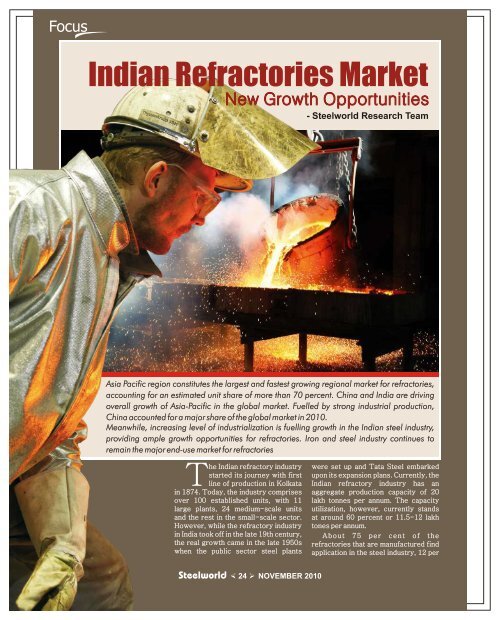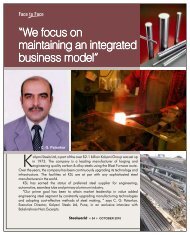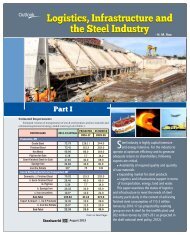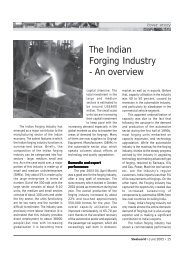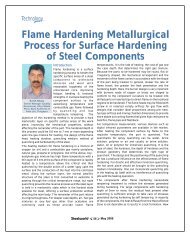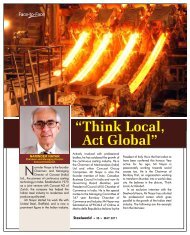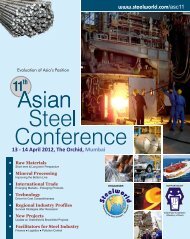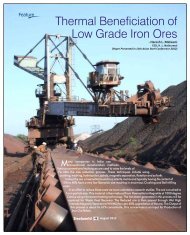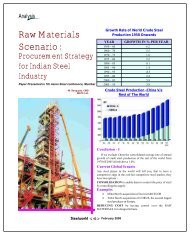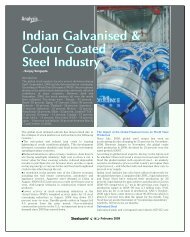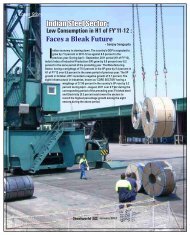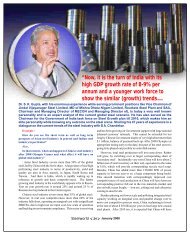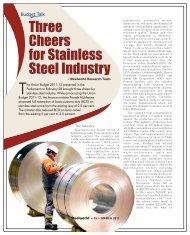Indian Refractories Market - Steelworld
Indian Refractories Market - Steelworld
Indian Refractories Market - Steelworld
You also want an ePaper? Increase the reach of your titles
YUMPU automatically turns print PDFs into web optimized ePapers that Google loves.
Focus<br />
<strong>Indian</strong> <strong>Refractories</strong> <strong>Market</strong><br />
New Growth Opportunities<br />
Asia Pacific region constitutes the largest and fastest growing regional market for refractories,<br />
accounting for an estimated unit share of more than 70 percent. China and India are driving<br />
overall growth of Asia-Pacific in the global market. Fuelled by strong industrial production,<br />
China accounted for a major share of the global market in 2010.<br />
Meanwhile, increasing level of industrialization is fuelling growth in the <strong>Indian</strong> steel industry,<br />
providing ample growth opportunities for refractories. Iron and steel industry continues to<br />
remain the major end-use market for refractories<br />
he <strong>Indian</strong> refractory industry<br />
started its journey with first<br />
Tline of production in Kolkata<br />
in 1874. Today, the industry comprises<br />
over 100 established units, with 11<br />
large plants, 24 medium-scale units<br />
and the rest in the small-scale sector.<br />
However, while the refractory industry<br />
in India took off in the late 19th century,<br />
the real growth came in the late 1950s<br />
when the public sector steel plants<br />
� 24 � NOVEMBER 2010<br />
were set up and Tata Steel embarked<br />
upon its expansion plans. Currently, the<br />
<strong>Indian</strong> refractory industry has an<br />
aggregate production capacity of 20<br />
lakh tonnes per annum. The capacity<br />
utilization, however, currently stands<br />
at around 60 percent or 11.5-12 lakh<br />
tones per annum.<br />
About 75 per cent of the<br />
refractories that are manufactured find<br />
application in the steel industry, 12 per
cent in the cement industry, 5-6 per<br />
cent in non-ferrous industries, three<br />
per cent in the glass industry and the<br />
b a l a n c e i n o t h e r i n d u s t r i e s .<br />
Necessarily, refractories are used<br />
either where high temperature or high<br />
rate of abrasion/corrosion/erosion is<br />
involved. Traditionally, refractories<br />
are made of naturally-occurring<br />
minerals, such as bauxite, kyanite,<br />
magnesite, fireclay, chrome ore, etc.<br />
Lately, however, the industry has been<br />
using man-made raw materials, such as<br />
brown-fused alumina, tabular alumina,<br />
fused magnesia, silicon carbide,<br />
magnesia alumina, etc.<br />
Refractory plays a dynamic role not<br />
only for metallurgical but also for<br />
s h a p i n g u p c h e m i c a l a n d<br />
petrochemical, glass, ceramic, cement<br />
and limestone industries. Major<br />
research work has so far been<br />
concentrated for the development of<br />
new refractory and also for its<br />
reduction in consumption for steel<br />
industries. But, the industry's efforts<br />
have so far proved futile as no major<br />
breakthrough has been achieved.<br />
<strong>Indian</strong> refractory industry, meanwhile,<br />
is required to upgrade their operations<br />
with global technologies which need<br />
huge investment. But, in the long run,<br />
the investment is bound to fetch higher<br />
returns too.<br />
Scope for Growth<br />
The size of the <strong>Indian</strong> refractory<br />
industry has been pegged at Rs 2,300<br />
crore and it is stated to be growing at<br />
8-10 per cent per annum. Although the<br />
specific consumption of refractories<br />
has gone down from 30 kg per tonne of<br />
steel about 20 years ago to 12-13 kg on<br />
an average for the steel industry as a<br />
whole and as low as 7-8 kg in the case<br />
of some more efficient steel units, the<br />
scope for growth is good in view of the<br />
continuing growth in the <strong>Indian</strong><br />
economy and the government's focus<br />
on infrastructure development.<br />
Despite downturn in steel sector,<br />
the domestic refractory industry that<br />
supplies raw materials to steel plants<br />
and industries, posted 21 percent<br />
growth in turnover at Rs 4,480 crore in<br />
2009-10 against Rs 3,640 crore in<br />
2008-09, when the growth was 16<br />
percent over 2007-08. The capacity<br />
utilization of the industry was 65<br />
percent.<br />
In 2009-10, the import of<br />
refractories was down 11 percent to Rs<br />
1,277 crore, according to <strong>Indian</strong><br />
Refractory Makers Association (IRMA)<br />
chairman, A K Chattopadhyay. This<br />
was largely due to drop in the imports<br />
of fireclay and high alumina bricks<br />
mostly under OEM contracts. But, then,<br />
the exports during the period also<br />
declined to Rs 446 crore mainly due to<br />
the meltdown in European and the<br />
American markets.<br />
Crude steel production in 2010-11<br />
is expected to rise to 72 million tonnes<br />
despite the slide in the first quarter. In<br />
2009-10, the crude steel production<br />
was 64.88 million tonne. Out of total<br />
production of 64.88 million tonne in<br />
2009-10, 29.33 million tonne was<br />
produced through the oxygen route,<br />
another 15.69 million tonne through the<br />
EAF route, and the balance through the<br />
induction furnace route. Cautioning<br />
against the frenzy to sign MoUs to set<br />
up steel plants 53 in Karnataka, 71 in<br />
Jharkhand and several dozens each in<br />
O r i s s a a n d W e s t B e n g a l ,<br />
Chattopadhyay said that infrastructure<br />
bottlenecks could throttle these<br />
ambitious plans. The production of 100<br />
million tonnes of crude steel would<br />
mean transportation of 350 tonnes of<br />
raw materials.<br />
According to Dr J.J. Irani, Director<br />
of Tata Sons and Former Managing<br />
Director of Tata Steel, “With the<br />
government aiming to invest more and<br />
more on infrastructure development,<br />
the steel industry in the country is<br />
slated to grow to, possibly, 120 million<br />
� 25 � NOVEMBER 2010<br />
Focus<br />
Refractory plays a dynamic<br />
role not only for metallurgical<br />
but also for shaping up<br />
chemical and petrochemical,<br />
glass, ceramic, cement and<br />
limestone industries. Major<br />
research work has so far been<br />
concentrated for the<br />
development of new<br />
refractory and also for its<br />
reduction in consumption for<br />
steel industries.<br />
tonnes or even up to 150 million tonnes<br />
by 2015. According to most reports, the<br />
cement, aluminium and other industries<br />
are also to grow to unprecedented<br />
heights. This should be good news for<br />
refractory producers in India.”<br />
Challenges For Industry<br />
“The Refractory Industry must<br />
upgrade itself to take benefit of<br />
increased business from the steel<br />
industry,” stated R K Vijayvergia,<br />
Executive Director-Operations, SAIL,<br />
at a recently held conference. In his<br />
special address, Vijayvergia said,<br />
“Steel industry forms the major enduse<br />
segment for refractories<br />
consuming around 70 percent of its<br />
total annual production. The Refractory<br />
Industry has to keep pace with steel<br />
industry with regard to quality and<br />
quantity demands. Meanwhile, with the<br />
changed business scenario more and<br />
more customers are looking forward to<br />
total refractory management which<br />
encompasses creation of value added<br />
service, responsive supply chain<br />
network and understanding of<br />
customers' requirement.”<br />
The major <strong>Indian</strong> refractory<br />
manufactures need to gear up to cater
Focus<br />
It would also be important<br />
for <strong>Indian</strong> refractory<br />
manufacturers to focus on<br />
their raw materials security.<br />
Industry insiders do<br />
acknowledge that raw<br />
materials security is a concern<br />
especially with China<br />
imposing quantitative<br />
restrictions on export of raw<br />
materials and also jacking up<br />
prices over the last year or so.<br />
the need of steel industry. World<br />
leaders in refractories like RHI from<br />
Austria, Vesuvius from Belgium,<br />
French giant Calderys, Pohang from<br />
South Korea etc have also made their<br />
presence in India, which is a good sign<br />
for the industry. Recently SAIL has<br />
taken over Bharat <strong>Refractories</strong> Ltd<br />
which is now named as SAIL<br />
Refractorry Unit (SRU). SAIL is in the<br />
process of augmenting and upgrading<br />
the facilities at SRU for higher<br />
production to meet the quality<br />
requirement of SAIL.<br />
Recycling and reuse of refractory is<br />
another area of utmost important. In<br />
order to reduce the volume of waste<br />
refractories, it is necessary to cut down<br />
their consumption by prolonging life<br />
furnace lining. In the field of refractory<br />
major technological development in the<br />
world have taken place in the area of<br />
monolithic and carbon containing<br />
refractories. Currently the share of<br />
monolithic in India is around 25 percent<br />
of total refractory consumption which<br />
is less than Japan where it is more than<br />
50 percent. Economic volatility and<br />
risks, information and communications,<br />
climate change, domestic reforms,<br />
inclusiveness and low cost innovations<br />
are the key influencing factors for the<br />
strategic direction of the business<br />
standards.<br />
Refractory producers in India have<br />
to rise to the occasion by providing<br />
ready, regular, speedy and consistent<br />
supplies, Irani said. It would also be<br />
important for <strong>Indian</strong> refractory<br />
manufacturers to focus on their raw<br />
materials security. Industry insiders do<br />
acknowledge that raw materials<br />
security is a concern especially with<br />
C h i n a i m p o s i n g q u a n t i t a t i v e<br />
restrictions on export of raw materials<br />
and also jacking up prices over the last<br />
year or so. Cheaper refractory imports<br />
from China are also putting a pressure<br />
on the industry's margins. Hiring and<br />
retaining skilled manpower is a major<br />
challenge that the <strong>Indian</strong> refractory<br />
industry has to cope with.<br />
Phenomenal Growth in Global<br />
<strong>Market</strong>s<br />
With the staggering recovery from<br />
last year's downturn in steel industry,<br />
the global refractories market will<br />
reach 59 million tonnes and $31 billion<br />
by 2015. Key market drivers include<br />
growing use in metal and non-metallic<br />
mineral products production; emerging<br />
markets such as China and India; and<br />
increased preference for lighter and<br />
stronger refractory materials.<br />
New and advanced products, as well<br />
as installation/repair practices, are also<br />
expected to spur global demand for<br />
refractories in the next few years.<br />
Global demand for refractories<br />
declined during late 2008 and into 2009<br />
as a result of the economic crisis and<br />
declining steel production and<br />
consumption. Steel use contracted by<br />
� 26 � NOVEMBER 2010<br />
6.2 percent in 2009. Nevertheless, with<br />
the economy gradually rebounding<br />
from recession and global steel<br />
production beginning to recoup,<br />
demand for refractories is forecast to<br />
increase starting in late 2010.<br />
Asia-Pacific constitutes the largest<br />
and fastest growing regional market for<br />
refractories, accounting for an<br />
estimated unit share of more than 70<br />
percent, according to the report. China<br />
and India are driving overall growth of<br />
Asia-Pacific in the global market.<br />
Fuelled by strong industrial production,<br />
China accounted for a major share of<br />
the global market in 2010.<br />
Meanwhile, an increasing level of<br />
industrialization is fueling growth in the<br />
<strong>Indian</strong> steel industry, providing ample<br />
growth opportunities for refractories.<br />
Iron and steel remains the major enduse<br />
market for refractories. However,<br />
the declining steel industry usage of<br />
refractories bodes well for the growth<br />
of refractories in other end-use<br />
sectors. Growth in the production of<br />
cement, ceramics and other mineral<br />
products is expected to complement<br />
this growing trend in the coming years.<br />
In addition, an upsurge in the use of<br />
refractories in metal and non-metallic<br />
mineral products' production is<br />
expected to widen the market's growth<br />
prospects.<br />
In terms of material, clay<br />
refractories represent the largest and<br />
fastest growing segment. The market is<br />
projected to grow at a CAGR of 6.6<br />
percent over the analysis period. The<br />
market for non-clay refractories is<br />
projected to reach 19.6 million metric<br />
tons by 2012. By form type, bricks and<br />
shapes represent the leading segment,<br />
while monolithics and others are<br />
projected to surpass $10.34 billion by<br />
2012.<br />
Growth prospects are high for<br />
monolithic castables and preformed<br />
shapes that feature higher performance<br />
and flexibility than other refractory<br />
forms. Significant growth potential is<br />
expected in zircon/zirconia, silicon<br />
carbide extra-high alumina, and other<br />
more specialized refractory materials<br />
that offer strong performance in<br />
specific applications. In addition, an
Focus<br />
above average growth is foreseen in<br />
the case of cost-effective refractory<br />
materials, including silica, highalumina,<br />
ceramic fibers, and insulating<br />
types.<br />
Recovery In Global Demand<br />
Global demand for refractories<br />
declined during late 2008 and in 2009,<br />
as a result of the economic crisis, and<br />
declining production and consumption<br />
of steel, the largest end-use market for<br />
refractories. Steel use contracted by<br />
6.2 per cent in 2009. Nevertheless,<br />
with the economy gradually rebounding<br />
from recession and the global steel<br />
production beginning to recoup,<br />
demand for refractories is forecast to<br />
increase starting from late 2010.<br />
Asia pacific constitutes the largest<br />
and fastest growing regional market for<br />
refractories, accounting for an<br />
estimated unit share of more than 70<br />
percent. China and India are driving<br />
overall growth of Asia-Pacific in the<br />
global market. Fuelled by strong<br />
industrial production, China accounted<br />
for a major share of the global market in<br />
2010.<br />
Growth Opportunities<br />
Meanwhile, increasing level of<br />
industrialization is fuelling growth in<br />
the <strong>Indian</strong> steel industry, providing<br />
ample growth opportunities for<br />
refractories. Iron and steel remains the<br />
major end-use market for refractories.<br />
However, the declining steel industry<br />
usage of refractories of late bodes well<br />
for the growth of refractories in other<br />
end-use sectors. Growth in production<br />
of cement, ceramics, as well as other<br />
mineral products is expected to<br />
complement this growing trend in the<br />
coming years. In addition, an upsurge in<br />
the use of refractories in metal and<br />
non-metallic mineral products<br />
production is expected to widen the<br />
market's growth prospects.<br />
In terms of material, clay<br />
refractories represent the largest and<br />
fastest growing segment. The market is<br />
projected to grow at a CAGR of 6.6<br />
percent over the next two years. The<br />
market of non-clay refractories is<br />
projected to reach 19.6 million tonnes<br />
by 2012. By form type, bricks and<br />
shapes represent the leading segment,<br />
while monolithics and others are<br />
projected to cross $10.34 billion by<br />
2012. Growth prospects are high for<br />
monolithic castables and preformed<br />
shapes that feature high performance<br />
and flexibility than other refractory<br />
forms. Significant growth potential is<br />
witnessed in zircon/zirconia, silicon<br />
carbide extra-high alumina, and other<br />
� 28 �<br />
NOVEMBER 2010<br />
Asia Pacific constitutes the<br />
largest and fastest growing<br />
regional market for refractories,<br />
accounting for an estimated<br />
unit share of more than 70<br />
percent. China and India are<br />
driving overall growth of<br />
Asia-Pacific in the global<br />
market. Fuelled by strong<br />
industrial production, China<br />
accounted for a major share<br />
of the global market in 2010.<br />
more specialised refractory materials<br />
that offer strong performance in<br />
specific applications. Besides, an above<br />
average growth is foreseen in the case<br />
of cost-effective refractory materials,<br />
including silica, high-alumina, ceramic<br />
fibres, and insulating types.


